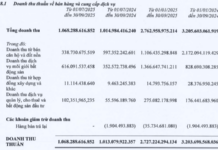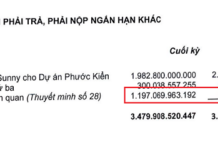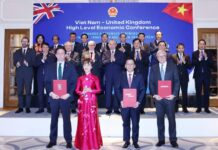Vietnam’s Offshore Wind Power Potential is Enormous
The ASEAN Business and Investment Summit (ABIS 2025) took place on October 25-26, with the participation of ASEAN leaders, international financial organizations, leading energy corporations, and the regional business community.
During the roundtable discussion titled “Energy Transition and ASEAN Power Grid – Connecting Markets, Securing the Future,” Deputy General Director of the Vietnam Oil and Gas Group (Petrovietnam) Le Manh Cuong emphasized the significance of the enhanced Memorandum of Understanding on the ASEAN Power Grid (APG). This memorandum lays the foundation for countries to strengthen their commitments and coordination in implementing cross-border energy projects.
From a corporate perspective, he believes that leading corporations such as TNB, Petronas, and Petrovietnam will enhance their collaboration to overcome technical challenges in project implementation.

Deputy General Director of Petrovietnam Le Manh Cuong at the discussion session within the framework of the ASEAN Business and Investment Summit 2025 (Photo: Petrovietnam)
The leader of Petrovietnam shared that Vietnam possesses an enormous offshore wind power potential, estimated at around 600,000 MW. To maximize this potential, the key factor is inter-country cooperation mechanisms, requiring connectivity and collaboration not only among energy enterprises but also among governments in the region, to focus resources and develop synchronized infrastructure.
Deputy General Director of Petrovietnam also mentioned that another critical issue in implementing large cross-border projects is focusing on the supply chain.
Regarding Petrovietnam, Mr. Cuong stated that oil and gas remain the core production sector and a vital resource for the Group to contribute to national development while promoting energy transition and developing sustainable renewable energy projects in the context of Vietnam and the region shifting to a low-carbon economy.
Mr. Le Manh Cuong affirmed that, alongside its energy transition strategy and renewable energy development, particularly offshore wind power, Petrovietnam will be a leading reliable partner to join TNB, ADB, and regional partners in turning the APG vision into reality.
Maximizing Offshore Wind Power Technical Potential for Electricity and New Energy Production
At a seminar with representatives of British enterprises investing in Vietnam in late June, Deputy Minister of Industry and Trade Nguyen Hoang Long reported that, following the issuance of Resolution 68, many corporations and private economic groups in Vietnam have submitted registrations to begin implementation. The Ministry of Industry and Trade expects that by the end of this year, Vietnam’s first offshore wind power project will commence.
According to the adjusted Power Master Plan VIII, Vietnam aims to maximize its offshore wind power technical potential (approximately 600,000 MW) for electricity and new energy production.
The total offshore wind power capacity serving domestic electricity demand is expected to reach around 6,000 MW – 17,032 MW, with operations scheduled for the 2030 – 2035 period. By 2050, the total capacity is projected to reach 113,503 – 139,097 MW.
According to the Plan, the estimated offshore wind power capacity for new energy production is around 15,000 MW by 2035 and approximately 240,000 MW by 2050.

According to the Ministry of Industry and Trade, after the issuance of Resolution 68, many corporations and private economic groups in Vietnam have submitted registrations to begin implementation
By 2030, the total capacity of power plants serving domestic demand (excluding exports) is targeted at 183,291 – 236,363 MW, with offshore wind power contributing 6,000 – 17,032 MW, scheduled for operation between 2030 – 2035, with the possibility of accelerating progress if conditions are favorable and costs are appropriate.
By 2050, the total capacity of power plants serving domestic demand (excluding exports) is projected to reach 774,503 – 838,681 MW. Offshore wind power is expected to account for 14.7 – 16.6%, with a capacity of 113,503 – 139,079 MW.
“First Rich Kid” Tiên Nguyễn’s Upcoming Wedding: Unveiling the Billion-Dollar Empire of Luxury Retail Tycoon Johnathan Hạnh Nguyễn, Vietnam’s Largest Luxury Retail Network Controller
As the daughter of Vietnam’s luxury tycoon Johnathan Hanh Nguyen, heiress Tiên Nguyễn is set to tie the knot, carrying with her the legacy of a multi-billion-dollar empire spanning luxury retail, aviation, and real estate.
What Should Vietnamese Businesses Do Following the Signing of the Hanoi Convention?
The UN Convention on Cybercrime, signed on October 25th, sets new mandates for Vietnamese businesses: rapidly enhance cybersecurity capabilities, align operations with international standards, proactively share incident data, and strengthen global coordination in investigation and response efforts.










































